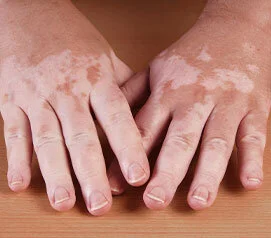Vitiligo
Listen to Dr. Greenberg on a Podcast
Vitiligo occurs when melanocytes (pigment producing cells) die or fail to produce melanin (a dark pigment responsible for skin color) resulting in white or lighter patches of skin. Let’s talk about what causes vitiligo and what we can do to treat it!
- Autoimmune disorder: Vitiligo is an autoimmune disorder where the body attacks and destroys melanocytes (pigment producing cells) in the skin.
- Prevalence: around 1% of the world’s population suffers from vitiligo. The psychological effects can be devastating.
- Nervous system related: melanocytes are derived from the same embryological cells as neurons (neural crest cells).
- Thyroid related: people with vitiligo have higher rates of hypothyroidism (Hashimoto’s) as well as hyperthyroidism (Graves).
What Causes Vitiligo?
While we still have a lot learn about exactly what causes vitiligo, we know that it is an autoimmune disease where the body attacks its own melanocytes via T-cells.
01. Genetics
Certain genes predispose people to developing vitiligo and it can run in families.
In the general population 1 in 100 people have vitiligo; your chances of having it increase to 1 in 20 if a parent or sibling also has it.
02. Catecholamine production
Catecholamines are hormones made by your adrenal glands and include: dopamine, epinephrine and norepinephrine.
People with vitiligo tend to have increased levels of catecholamines in their urine and blood. The reason for this is unknown.
03. Oxidative stress
Free radicals are unstable molecules that can attack and damage healthy cells.
Increased levels of free radicals occur in active vitiligo skin cells.
Excess levels of dopamine can cause oxidative stress in neurons.
What Aggravates Vitiligo?
Stress
Alcohol
Sunburn
Lack of sleep
Exposure to chemicals
How Can We Get Rid of Vitiligo?
While there is no proven cure for vitiligo, we target it from the inside out and outside in by using both topicals and internal treatments to improve pigmentation and stop the spread.
We work with you, the patient, to determine which treatment options fit best with your life and your values. There is no “one-size-fits-all” treatment plan: it will be tailored to your specific needs.
Examples include:
Diet
We educate you on how you can adjust your diet to help improve your vitiligo.

Topicals
We use natural botanical products to address the loss of skin pigmentation.

Supplements
There are many supplements which can help address the underlying causes of vitiligo such as increased catecholamine production and oxidative stress.
Supplement treatment plans are customized to the individual.

Lifestyle
We will look at lifestyle factors like chemicals and sun exposure to determine which factors could be contributing to your vitiligo.
We will look at your stress levels, sleep, and exercise to determine what changes could help calm your vitiligo.
Interested in learning more about how we treat vitiligo?
Contact us or set up a free 15 minute consultation with Dr. Greenberg to talk about your specific needs.
Contact Us
Los Angeles, CA 90024






